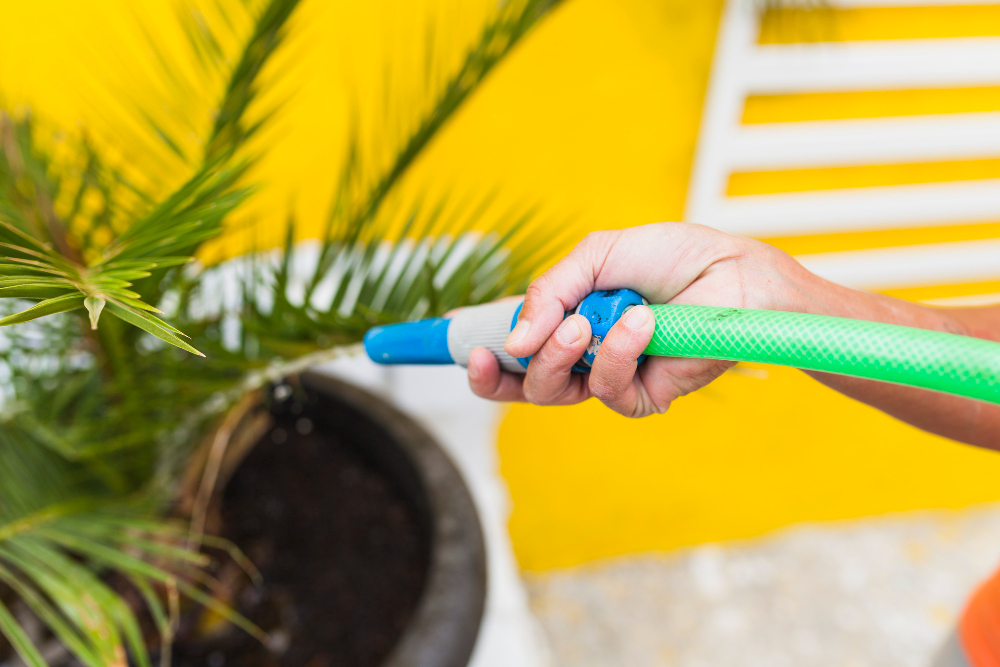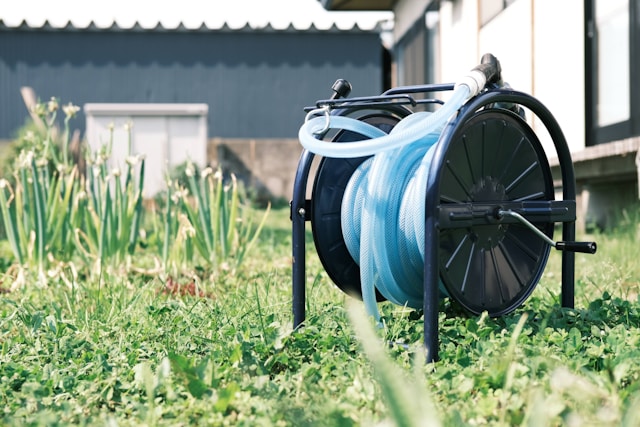
When you’re in the market for a new garden hose, you might be surprised by how many options there are. However not all hoses are created equal, and knowing what to look for can save you from the frustration of dealing with a subpar product. A quality garden hose can make your gardening tasks easier and more enjoyable, while a poor choice can lead to leaks, kinks, and unnecessary hassle.
Here’s a comprehensive buying guide to help you find a garden hose that meets your needs and lasts for years.
Assess the Material
The material from which a garden hose is made plays a pivotal role in its overall performance, longevity, and ease of use. Understanding the differences between the types of materials can help you make an informed decision that aligns with your gardening requirements and preferences.
Vinyl Hoses
Vinyl hoses, made from PVC (polyvinyl chloride), are the go-to choice for casual gardeners and those looking for a cost-effective solution. Their lightweight nature makes them easy to maneuver around small gardens, patios, or balconies.
However, their affordability comes with a trade-off. Vinyl hoses are more susceptible to damage from environmental factors. They can become brittle and crack when exposed to cold temperatures, and prolonged exposure to sunlight can degrade the material, leading to leaks.
Ideal for:
- Light watering tasks such as filling containers or watering potted plants.
- People of all strengths and ages.
- Mild climates or gardens with minimal watering needs.
Rubber Hoses
Rubber hoses represent the premium end of the garden hose spectrum. Constructed from natural or synthetic rubber, these hoses boast superior durability and flexibility. Unlike vinyl hoses, rubber hoses are resilient and can withstand a wide range of temperatures. They are also less likely to kink or twist.
Their robust construction, however, means they are heavier and more challenging to maneuver, which could be a consideration for those with larger gardens or mobility issues.
Ideal for:
- Heavy-duty usage such as watering large gardens, cleaning driveways, and filling large water features.
- Gardeners who prioritize durability and longevity in their gardening tools.
Reinforced Hoses
For gardeners seeking a middle ground between the affordability of vinyl and the durability of rubber, reinforced hoses present an excellent compromise. These hoses are constructed with a core of vinyl or rubber that is encased in a mesh layer made from nylon or polyester.
This reinforcement provides added strength, reducing the likelihood of kinking and bursting under high water pressure. While reinforced hoses may cost more than basic vinyl options, their enhanced durability and flexibility offer a valuable investment for serious gardeners looking for reliability without the weight and cost of a pure rubber hose.
Ideal for:
- Wide range of gardening tasks, from moderate watering to more intensive cleaning jobs.
- All types of garden layouts and sizes.
Consider the Length: Matching Hose to Garden Size
The length of your garden hose should be determined by the furthest distance from your water spigot to the edges of your garden or any areas requiring watering. While it might seem like a good idea to opt for the longest hose possible to cover all bases, this approach can lead to several issues:
- Weight and Maneuverability: Longer hoses are significantly heavier and more difficult to move around, especially when filled with water. This can make watering tasks more laborious and time-consuming, particularly for larger gardens.
- Storage: Storing a long hose can be challenging, requiring more space and often a hose reel to keep it neatly coiled and out of the way when not in use.
- Water Pressure: Perhaps most importantly, longer hoses can experience a drop in water pressure. The further the water has to travel, the less force it will have when it exits the nozzle, potentially affecting your ability to effectively water plants at the far reaches of your garden.
For most residential gardens, hoses ranging from 50 to 75 feet offer a good balance, providing ample reach without the drawbacks of excessive length. However, if your garden layout is compact or your spigot is centrally located, a shorter hose might suffice.
Diameter: Balancing Flow and Pressure
The diameter of your hose plays a crucial role in determining water flow and pressure. This is not just about how quickly you can fill a watering can, but also about the efficiency and effectiveness of sprinklers or other hose-end attachments.
- ½ inch: Hoses with a ½-inch diameter are lighter and more flexible, but they offer a lower water flow. This size might be suitable for small gardens or tasks that require less water volume.
- 5/8 inch: This diameter is the most versatile, providing a good balance of water flow and pressure suitable for the majority of gardening tasks. It’s ideal for medium to large gardens where you need sufficient water volume without sacrificing pressure.
- ¾ inch: For gardens requiring high volumes of water or for use with sprinkler systems covering large areas, a ¾-inch hose delivers the highest water flow. Keep in mind, though, that these hoses are heavier and may require more storage space.
For a garden with average watering requirements, encompassing a mix of tasks from watering plants to using sprinklers and hose-end attachments, the 5/8-inch diameter hose stands out as the best choice. Its versatility in providing a balanced water flow and pressure makes it ideally suited for a wide range of gardening activities.
Flexibility and Kink Resistance
Flexibility and kink resistance are key qualities that enhance the user experience by ensuring smooth operation during watering tasks. A flexible garden hose adapts easily to various garden layouts, navigating around corners, plants, and other obstacles without tangling or causing frustration.
Moreover, kink-resistant hoses are designed with either special materials or reinforced structures that prevent the hose from folding over on itself, which not only maintains a consistent water flow but also extends the lifespan of the hose by reducing wear and tear at the kink points.
Investing in a hose that combines these features means less time dealing with interruptions and more time enjoying the gardening process, making flexibility and kink resistance highly desirable attributes in a quality garden hose.
Couplings: The Connection Matters
Couplings are the fittings on the ends of the hose that connect to the spigot and your nozzle or sprinkler.
Quality hoses have brass or metal couplings rather than plastic. Brass is more durable, less likely to crack or leak, and provides a tighter connection.
UV Resistance and Weather Tolerance
If your hose will spend a lot of time in the sun, look for a UV-resistant garden hose to prevent it from becoming brittle and cracking.
Additionally, consider the climate you live in. Some hoses are designed to remain flexible in cold temperatures, while others can withstand hot climates without degrading.
Environmental and Health Safety Considerations
For those using hoses to water edible plants or for filling pet water bowls, consider hoses labeled as “drinking water safe” or made from materials that do not leach chemicals.
These hoses are typically made from FDA-approved materials that ensure the water remains uncontaminated and safe for consumption.
Environmentally conscious gardeners might look for hoses made from recycled materials or those designed to be fully recyclable, reducing the environmental footprint of their gardening activities.
Ease of Storage

To keep your garden tidy and extend the life of your hose, consider the ease of storage.
Hose reels can be portable or wall-mounted and help to neatly coil your hose, preventing kinks and damage. Hose hangers are also a simpler option that allows the hose to be hung out of the way when not in use.
Another option to consider is expandable hoses.
These hoses extend when filled with water and retract to a fraction of their size when empty, making storage a breeze. They are a great option for those with limited storage space or who find traditional hoses too bulky or difficult to manage.
Warranty and Brand Reputation
Look for products that come with a warranty, indicating the manufacturer’s confidence in their durability and performance.
Warranties can range from a few years to lifetime coverage.
Always consider purchasing from reputable brands known for their quality and customer service. Reading reviews and seeking recommendations from fellow gardeners can provide insight into which brands consistently deliver on their promises.
Final Thoughts
Choosing the right garden hose involves balancing various factors, including material, length, diameter, flexibility, and additional features like UV resistance and non-toxic construction.
By considering your specific gardening needs, you can select a hose that not only makes watering tasks more efficient and enjoyable but also stands the test of time.
Remember, the best garden hose is one that fits your garden’s unique requirements and enhances your overall gardening experience.
